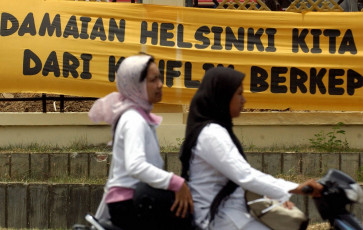Popular Reads
Top Results
Can't find what you're looking for?
View all search resultsPopular Reads
Top Results
Can't find what you're looking for?
View all search resultsClimb ev'ry mountain
Mt Merapi, viewed from Mt Merbabu, Central JavaIndonesia is a hiker’s paradise, but sometimes it can be tough just knowing where to start
Change text size
Gift Premium Articles
to Anyone

Mt Merapi, viewed from Mt Merbabu, Central Java
Indonesia is a hiker’s paradise, but sometimes it can be tough just knowing where to start. A new website aims to help you take the first step.
Dan Quinn makes lists. He makes lists of things to do. He makes lists of things to buy. And he’s made a list of mountains to climb.
“Without a list,” he says, “I don’t get things done.”
One of the things he wants to get done is to climb at least 100 of Indonesia’s “Ribus”.
A “Ribu” is the term humorously coined for a mountain in Indonesia with an elevation of (as the name suggests) at least 1,000 meters. There are around 130 of these dotted across the archipelago, all listed on the Gunung Bagging website, www.gunungbagging.com.
The Gunung Bagging website is the brainchild of Quinn and fellow Briton Dr Andy Dean. The two hiking enthusiasts met earlier this year on a trip with hiking group Java Lava. Once chatting, they shared their frustration at the lack of comprehensive and accessible practical information on how to climb Indonesia’s hundreds of peaks. The fresh air and physical exercise obviously did them some good, because by the time they came down from the mountain, they had hatched a plot to create such a resource.
Now, several months later, the combination of their passion for climbing, Dean’s scientific and technical knowledge (he is a geographer by training) and Quinn’s writing skills has resulted in the Gunung Bagging website, a clean, user-friendly and helpful resource on Indonesia’s mountains and how to climb them.
The name, in case you’re wondering, comes from the English and Scottish pastime of “mountain bagging” — trying to climb (or “bag”) all mountains above 3,000 feet (about 1,000 meters).
The idea of the “Ribus” is based on the list of “Ultras” — peaks around the world of more than 1,500 meters.
“Here, if you follow 1,500 meters as for the Ultras, you really run out of options [for hikes] from Jakarta on the weekends and many are missing,” Quinn explains. “So we brought that prominence down to 1,000.” (Their methodology for identifying the peaks is detailed on the website.)
The website lists 123 of these, divided into three categories: sangat tinggi (really high: >3000 meters; there are 30 of these); tinggi sedang (quite high: 2,000–3,000 meters; 49) and kurang tinggi (not all that high: 1,000–2,000 meters; 44). Also included are 20 spesials — mountains that might not make the grade in terms of height, but make up for it with other properties (Anak Krakatau being the obvious entrant here; it’s a midget at only 264 m but its cracker personality always makes it the life of the party). The website also organizes the mountains by province.
The idea is for each entry on each mountain to give information about elevation, location and practical information about how to “Bag it!” plus any other relevant and interesting information.
But that’s a lot of information and a lot of mountains. “We can’t climb them all so we will require information. It’s a collaborative effort,” Quinn says.
“We do both want to stress that it is not finished — it is a framework,” Dean says. “And we want people to contribute to it.”

While there are a few famous mountains on which a lot of information is available, he adds, “There are hundreds of volcanoes with very little information and definitely people who have climbed them. … There is definitely a large group — bigger than you might expect — of Indonesian people who do a lot of climbing of volcanoes.”
Each entry has a space to enter comments (scroll down past the Google Satellite Image) so anyone can enter a comment, containing useful practical information about how to climb the mountain — where to start from, difficulty and how long it might take a moderately fit walker, equipment needed, facilities available, etc.
All comments are moderated — “we want to try and remain impartial rather than slagging off a porter or something” — and all contributors credited. Although the website is in English, useful comments written in Indonesian will also be included.
In this way, the website aims to cater both to those who are “prominence fanatics”, who take mountain climbing very seriously, and to those who’d just like to get out of the city and go on an enjoyable walk.
Either way, Quinn says, “We want to make it easier for people to do things and visit places.”
And if you should manage to “bag” 20 of Indonesia’s volcanoes, you can even enter your name in the Gunung Bagging “Hall of Fame” — you could even be the first. But if you haven’t started yet, you’ll have some catching up to do.

Quinn, who came to Indonesia a year ago because of his fascination for gamelan (“the volcanoes were an added bonus”), has already started ticking them off on his list.
“When I moved here, I thought, great, you know, if I could climb five this year it would be brilliant,” he says. “I think I’ve done 13 or 14.”
Dean, who was a keen hiker in the UK and then Canada, where he lived for five years, has also pulled together a respectable count in his couple of years living in Indonesia.
“I’ve managed to climb 10 or 11 volcanoes, and have realized that climbing volcanoes in Indonesia is not that difficult,” he says.
“I like the physical challenge of climbing the volcanoes in Indonesia and the view from the summit at sunrise and sunset. And in Indonesia, as long as you don’t climb on the Independence Day weekend, you can actually escape from people. Java is pretty crowded, but there are parts of Java you can be really impressed by the forest and get away from the crowds.”

But too often, he adds, it is difficult to know where to start. “Sometimes it can just seem too hard, and you can really decide not to bother. That’s an important motivation for us.”
“I hope it will encourage people to go to places they might not visit otherwise,” Quinn says. “As people visit more a place more often, it becomes more accessible.”
There’s a benefit for everyone. Practice responsible hiking, and the local economy around the mountain gets a boost from the visitors. And the benefits for hikers are manifold.
“Firstly, it’s just going for a walk in a natural environment,” Quinn says. “It’s such a simple pleasure that many people are very disconnected from these days.”
As such, it’s good for both mental and physical health.
“You generally come back with a fresh perspective on things that had been troubling you at work or in life generally,” he says. “You learn more about the place you live in, get away from that disconnect of just sitting behind a computer or in a car.”
— Photos by Daniel Quinn
Dr Andy Dean and Dan Quinn will be launching www.gunungbagging.com, with a website demonstration and Q&A session, on Saturday Dec. 12, 3 p.m., at Eastern Promise, Kemang. They can be contacted via the website.
Good for …
A weekend out of Jakarta
• Rajabasa, Lampung (1,248 m)
• Ciremai, West Java (3,078 m)
• Cikoray, West Java (2,820 m)
Taking in the sunset
• Lawu, East Java (3,265 m)
Making sunrise worth getting up for
• Butak, East Java (2,868 m)
Family outings
• Papandayan, West Java (2,643 m)
Mad bastards (just getting to the starting point is an adventure…)
• Tambora, West Nusa Tenggara (2,730 m)
• Rantemario, South Sulawesi (3,478 m)
Romantics
• Batur, Bali (1,675 m)
Folklore lovers
• Agung, Bali (3,031 m)
The unfit, unable or just plain lazy
• Tangkuban Perahu, West Java (2,075 m) (you don’t even hve to get out of the car)
Solitude … just getting away from it all
• Most of them really …
Some interesting facts
Highest Ribu: Carstensz Pyramid, Puncak Jaya, Papua (4,884 m)
Lowest Ribu: Tombia, Central Sulawesi (1,022 m)
Most western Ribu: Hulumasen, Aceh (2,310 m)
Most eastern Ribu: Cycloop, East Papua (2,000 m)
Most northern Ribu: Seulawah Agam, Aceh (1,810 m)
Most southern Ribu: Wanggameti, East Nusa Tenggara (1,225 m)
Provinces with the most Ribus: West Java & East Java









